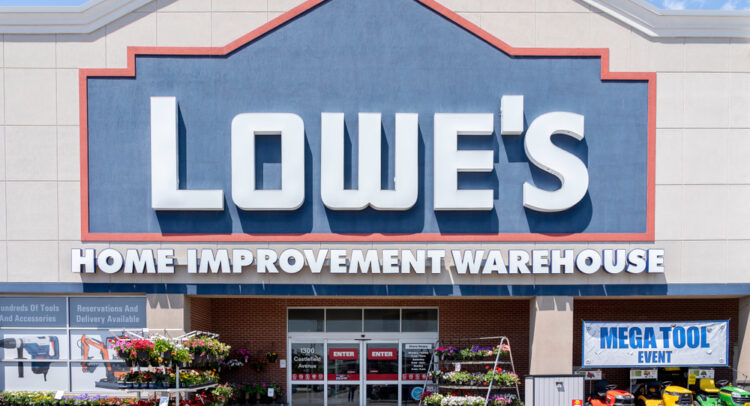You don’t have to focus on every company that beats quarterly estimates to find the best stock picks. Lowe’s (LOW) is a perfect example, as the company’s forward guidance is just as important as its past statistics. I am neutral on LOW stock because Lowe’s missed a key metric (comparable-store sales) and the company’s outlook suggests softness in sales, despite its CEO’s efforts to instill confidence in its investors.
Claim 50% Off TipRanks Premium and Invest with Confidence
- Unlock hedge-fund level data and powerful investing tools designed to help you make smarter, sharper decisions
- Stay ahead of the market with the latest news and analysis so your portfolio is always positioned for maximum potential
Lowe’s operates a chain of retail do-it-yourself home-improvement stores. If Home Depot (HD) is the best-known contender in this space in the U.S., then Lowe’s would be the runner-up to Home Depot.
The U.S. inflation rate isn’t as high as a couple of years ago, but this doesn’t mean the prices of goods and services are lower. It only means that things are getting more expensive at a slower pace. This is a problem for LOW stock since people delay home-improvement projects when they’re financially squeezed.
So, let’s see if this problem appeared in Lowe’s recently released results and guidance.
Lowe’s Stock Slides Despite Earnings Beat
Beating consensus estimated is usually considered as positive news. However, In this case, the earnings beat tells a more complicated story, therefore, strengthening my neutral position. Let’s explain why:
More often than not, when a stock falls despite the company beating Wall Street’s earnings estimate, it can present a prime buying opportunity. However, in the case of Lowe’s, the share-price slide seems to show that the market has legitimate concerns about the company.
For one thing, the company generated revenue of $23.6 billion, down 5.6% from $25 billion in the year-earlier quarter. Also, this result missed the analysts’ consensus estimate of $23.93 billion in quarterly revenue.
On the other hand, Lowe’s reported Q2-2024 adjusted diluted earnings of $4.10 per share. The bulls can celebrate this result because it surpassed Wall Street’s consensus forecast of $3.96 per share. However, the market seemed to sense something wasn’t ideal about this situation since LOW stock slipped into the red early on Tuesday morning.
One problem is that Lowe’s earned $4.56 per share in the year-earlier quarter. Therefore, the company’s Q2-2024 result of $4.10 per share represents a year-over-year fall-off of approximately 10%. In other words, despite the earnings beat, Lowe’s sales decline clearly affects the company’s bottom line.
Don’t Ignore This Key Metric for Lowe’s
In addition to what I claimed above, comparable-store sales are another metric that keeps me on the sidelines regarding LOW stock.
In retail store chains, comparable-store sales are a crucial measure of a company’s overall financial well-being. In the case of LOW, the company’s second-quarter 2024 comparable-store sales declined 5.1% year-over-year. In contrast, analysts had expected Lowe’s comparable-store sales to fall by only 4.4%.
From its own perspective, the company blamed “continued pressure in DIY” or do-it-yourself “bigger ticket discretionary spending,” which is bound to happen when consumers are dealing with price inflation. The company also cited “unfavorable weather adversely impacting sales in seasonal and other outdoor categories.” Unfavorable weather conditions will come and go, but high prices may be here to stay, which doesn’t bode well for Lowe’s.
Lowe’s Downward-Revises Its Forward Guidance
The final factor making me neutral is Lowe’s changed outlook for the full year of 2024. The changes weren’t optimistic. First, the company lowered its sales guidance from $84 – $85 billion to $82.7 – $83.2 billion.
Also, Lowe’s now expects its comparable-store sales to decline by 3.5% to 4% year over year in 2024, compared to its previous guidance of 2% to 3%.
Another disappointing outlook is Lowe’s calls for 2024 adjusted diluted earnings of approximately $11.70 to $11.90 per share. The company’s previous guidance was for full-year earnings of $12 to $12.30 per share.
Lowe’s CEO, Marvin Ellison, attempted to reassure the company’s investors, declaring, “As we look ahead, we are confident that we are making the right long-term investments to take share when the market recovers.” Ellison’s confidence should be expected since he’s a spokesman for the company. Yet, Lowe’s actual data and guidance don’t justify a highly confident outlook for the near future.
Is Lowe’s Stock a Buy, According to Analysts?
On TipRanks, LOW stock comes in as a Moderate Buy based on 11 Buys and 11 Hold ratings assigned by analysts in the past three months. The average Lowe’s stock price target is $254.37, implying 5.84% upside potential.
If you’re wondering which analyst you should follow if you want to buy and sell LOW stock, the most accurate analyst covering the stock (on a one-year timeframe) is Scot Ciccarelli of Truist Financial, with an average return of 21.88% per rating and an 87% success rate. Click on the image below to learn more.

Conclusion: Should You Consider Lowe’s Stock?
Lowe’s CEO wants to inspire confidence in the company’s ability to face an uncertain future. This won’t be easy for Lowe’s since some Americans are probably delaying their home-improvement projects due to persistently high product and service prices.
Lowe’s might stage an impressive recovery in comparable-store sales in the coming quarters, but this isn’t assured. Besides, Lowe’s downward-revised forward guidance should make prospective investors think twice. Consequently, I am staying on the sidelines and will not rush into purchasing LOW stock right now.
















